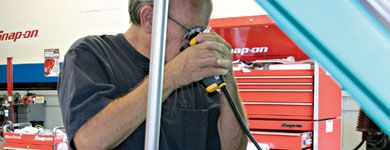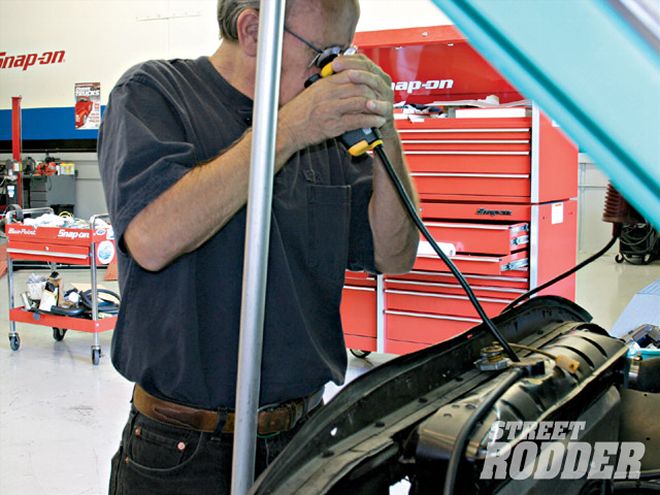
 Dirt and debris in the radiator core is one of the most common problems radiators fall prey to and can greatly reduce its ability to dissipate heat. Here, Don Armstrong from U.S. Radiator uses an oscilloscope to check on the condition of a radiator core.
Dirt and debris in the radiator core is one of the most common problems radiators fall prey to and can greatly reduce its ability to dissipate heat. Here, Don Armstrong from U.S. Radiator uses an oscilloscope to check on the condition of a radiator core.
Falling victim to radiator boil-over or having your hot rod vapor lock while cruising through town is never a good feeling. Finding yourself in the left turn lane at a red light with the engine sputtering and the temp gauge rising has certainly put a few grey hairs on my head, with some falling out completely. While I enjoy pushing my steaming hot rod through busy intersections as Joe Public lashes obscenities at me, there really isn't a good reason why any hot rod should be overheating to begin with. A properly set up cooling system should be able to keep even the most radical engine configurations in the most cramped engine compartments at or under a realistic operating temperature. That being said though, it is a common problem we see day in and day out at street rod events across the country and even on some of our own projects. But before one can tackle a cooling system issue, we need to understand the basics of said system and what causes most vehicles to overheat.
The standard liquid cooling system is made up of passages inside the engine block and heads where coolant is circulated via a water pump and cooled by passing through a radiator, controlled by a thermostat and pressurized by the radiator cap. The circulating coolant soaks up the heat from the engine as it travels through the water passages in the block and heads and is cooled by the airstream as it travels through the radiator. Once cooled, it travels back through the engine to absorb more heat. To ensure that the coolant stays above a certain temperature and that the water pump doesn't force the coolant through the radiator too quickly, a thermostat is used between the engine and the radiator. When left out, the coolant is "pushed" through the radiator and not allowed sufficient time to cool in the air stream. Conversely, the absence of the thermostat can lead to an engine that never reaches optimum operating temperature (usually between 190 to 195 degrees). In order to prevent the coolant from boiling, the system is pressurized, raising the boiling point considerably. Too much pressure, however, can cause the hoses and other parts to burst, so a radiator cap designed to release pressure at a specified point is used. The pressure released by the cap is contained in an overflow container and plumbed on a closed system that returns the coolant back to the radiator once the pressure has subsided.
An overheating situation can occur anytime the cooling system's ability to absorb, transport, or dissipate heat is breached. This can be caused by something as simple as low coolant level or a defective radiator cap to poor airflow through the radiator. The ability of the cooling system to properly circulate coolant through the engine and radiator directly affects its ability to shed heat. When the coolant's circulation is restricted by means other than the appropriate thermostat, temperatures begin to rise and the engine starts to overheat. Additionally, if the air flow through the radiator is inefficient, such as at low speeds or due to a faulty fan, the radiator will fail to do its job.
Having a vehicle that has a tendency to overheat can be a frustrating predicament to say the least. Stuck in traffic with a climbing temp gauge can make for an extremely stressful afternoon. And when this becomes your experience every time you take out your ride, those trips are going to become less and less frequent. Armed with a bit of knowledge on how a cooling system functions however can be the difference between a hot rod that overheats and a hot rod that used to overheat.